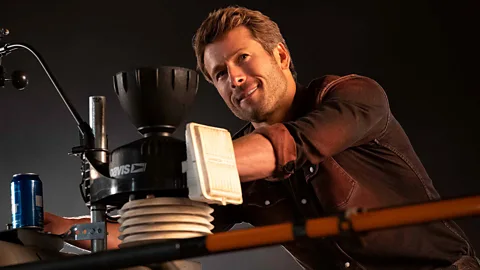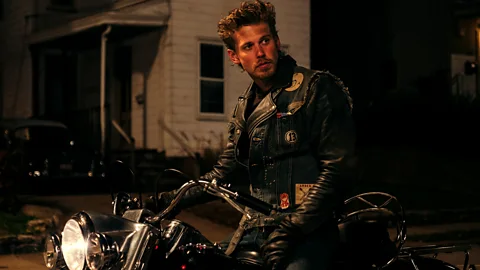Are genuine movie stars being born again?

10 hours ago
By Christina Newland,
 Universal
UniversalFor a while, there’s been talk of ‘the death of stardom’, with young actors not able to match the clout of Tom Cruise, Julia Roberts, Will Smith et al. But that might be changing.
There has been no lack of conjecture about what, precisely, makes a Movie Star. Most people would easily name examples for you, but might struggle to define why or how those examples were special. Film scholar Richard Dyer calls the star both “ordinary and extraordinary” in his seminal 1979 text, Stars, while academic and writer Jeanine Basinger, in her 2007 book The Star Machine, writes of Hollywood’s production line: “Sometimes a manufactured product turned out perfectly. Sometimes it blew up in the shopping cart”. And as Lauren Bacall once put it: “Stardom isn’t a profession. It’s an accident.”
For the powers that be, it certainly seems that whenever you try to bottle it or reproduce stardom, it vanishes. Many square-jawed hunks who look the part – say, Sam Worthington in Avatar, for instance – have been tried out by major Hollywood studios and fallen totally flat with audiences. Meanwhile others – like skinny teenager Timothée Chalamet in gay romance Call Me By Your Name – have climbed a strange and stellar path to the A-list. He is starring in mega-sci-fi franchise Dune, whereas in another decade he’d be doomed to playing foppish kid brothers in perpetuity. The fact that stardom has a kind of sketchy refusal to follow any exact science is maybe what makes it so endlessly fascinating to discuss.
 Universal
UniversalIn a changing Hollywood post-Covid, with cinemas under threat and once-all-powerful streamers in disarray, it has been said frequently that there are no new movie stars. Perhaps movies had become too CGI-driven, too high-concept, too much about explosions and superheroes to really care about the human element, or faces in close-up that had been central to drawing crowds in the past. As Charles Bramesco, a film critic for The Guardian with a special interest in film stardom, says: “The dearth of movie stars is downstream from a grander and more elaborate problem, which is the studio system’s turn away from the mid-budget vehicles that turned likeable talents into household names”. In recent years, there have been many less adult dramas, as well as comedies, especially of the romantic variety, which as Bramesco points out, “were once the bread and butter of Big Hollywood – but the (false) industry wisdom that they can’t be banked on as reliably as special-effects bonanzas has resulted in big-time brain drain”.
The ‘new A-List’
That might account for why one of our biggest current contenders for the role of Movie Star – Glen Powell – first got mainstream audience members’ attention with the box-office success of a romantic comedy. Last year’s rom-com Anyone But You, opposite fellow burgeoning star Sydney Sweeney, is the kind of late 90s/early 00’s throwback wherein two very attractive people hate each other but through a series of zany plot machinations are forced to admit they actually love each other. Powell, handsome in the old-school sense, with wavy blond hair and a sharp jawline, is a Texan to top it all off (even his name makes him sound like he should be in 1940s pictures with the likes of Tyrone Power). Powell first played supporting roles in films like Top Gun: Maverick as the jock you loved to hate but also kind of loved. (Tim Rothman, chairman and CEO of Sony Pictures, recently told Variety that “Glen is the classic example of talent meeting opportunity.”) Anyone But You went on to gross $220 million in cinemas internationally, starting off slow but becoming a sleeper hit, through word-of-mouth and a long theatrical window.
Similarly, in Richard Linklater’s comic crime caper Hit Man, now on Netflix, Powell has bursting romantic chemistry with love interest Adria Arjona; along with the film’s perfect calibration of Powell’s sexiness and goofiness, it’s no surprise he’s been embraced by audiences. Combined with red carpet footage of him toting his pet dog Brisket – and more importantly, perhaps, Tom Cruise’s tacit approval of Powell as a successor when he appeared to support his former co-star at the European premiere of Powell’s latest film Twisters – this man seems to be the genuine article. His co-starring role (as a swaggering Texan, no less) in Twisters, a spectacle-driven but old-school disaster blockbuster which is aiming for big box office this July, shows that the actor can helm big, action-packed mainstream releases.
 Amazon MGM
Amazon MGMAnd so, slowly, unexpectedly, along has come a new crop of screen talent that is finally leaving an impression again. Margot Robbie, who had first registered as little more than an impressively sexy blip on the Hollywood radar after her turn in Martin Scorsese’s Wolf of Wall Street, has seized control of her career, become a creative producer, and taken on a series of roles cementing her as a Movie Star. Now, she’s Barbie. And then there’s been the rise of throwback cornfed all-American boys like Austin Butler, who shot to fame for his heavily Method performance in Baz Luhrmann’s biopic Elvis. The Hollywood Reporter, who recently published a “new A-list” piece with Butler at the top, shares that the industry talk is about Butler as a leading man for all seasons. Another big cultural presence is Zendaya, whose earnings for co-producing and starring in sexy sports flick Challengers totalled $10 million alone, with its success proving that she could transcend it-girl status for a proper screen role in an original, non-franchise studio film. If THR are to be believed, there really is a brand new wave of bona-fide Movie Stars primed for our screens.
How stars are made
None of these figures were overnight sensations, and in fact, few real movie stars are. There’s often one major film that is identified in retrospect as their star-making turn, but there are years of forgotten television roles and smaller parts that build up the constellation before a Movie Star emerges. Butler was a child star on Nickelodeon for much of his adolescence; Robbie, like many of her Australian cohort, first appeared on popular daytime soap Neighbours; Powell appeared in small parts in films like Hidden Figures, and many others emerged from television to serious acting careers, with HBO’s teen drama Euphoria boasting a pretty remarkable trio of alumni: Zendaya, Jacob Elordi and Sydney Sweeney.
As has always been the case, extratextual information about the lives, loves, and tribulations of stardom allows the audience to feel closer to these immortal screen gods – whether supplied by the studio-controlled fan magazines of old or the far more freewheeling celebrity press of today. Tribes of Zendaya or Glen Powell fans on social media, who share interview tidbits or red-carpet moments obsessively, offer a (usually rather successful) addition to the overall likeability and persona of their favourite actor. As Charles Bramesco points out: “The parasocial dimension of fandom has never been stronger, and media (social and otherwise) lies at the heart of the belief that famous people are our friends. With many of these young stars, we can see media-circuit savvy with the gamut of stage-managed video appearances on Hot Ones and the like.” Hot Ones, the madly popular Youtube interview show featuring A-listers eating increasingly spicy hot wings while answering questions, is a great example of how we sometimes like to see our movie stars faced with some real-life discomfort in spite of their godlike status.
If Robbie, who seems to have a combination of ironclad business sense, down-to-earth charm, and preternatural sweetness – all while looking like Barbie herself – surprises viewers who, in accordance with sexist stereotypes, might expect her to seem aloof or vapid, all the better for it. It adds layers to her star persona, and it’s what keeps people returning to her and her films. Meanwhile, Timothée Chalamet cultivates a deeply caring image when it comes to his fans, devoting much of his time to taking photos with and greeting them at events; the likeability factor is an important one.
 Warner Bros
Warner Bros“There’s no substitute for charisma, and while many in the new generation of up-and-comers play on our nostalgia for a glamorous past, Powell’s social-media savvy and puppydog relatability have placed him ahead of the pack,” Bramesco notes. By contrast, though, a figure like Austin Butler has managed to cultivate a mystique, rarely posting to social media, and offering a slightly taciturn smoulder in all his interviews. Whether it’s old-school Hollywood mystery or Glen Powell thirst-trapping on Instagram, both stars have made their personalities work for them.
A Movie Star, historically, conformed to a certain “type” – studios often had factory-line production strategies that required easy access to, say, a mysterious and dark-eyed stranger, or a matronly aunt with a comic streak, or an innocent blonde waif. Whether emerging from the stage, like the fearsomely beautiful screen-natural Vivien Leigh, or a village beauty contest, or a tenement slum like Barbara Stanwyck, there’s a Cinderella-story element to the traditional movie star tale. But stars are rarely just innocently “discovered”, as the old story about 40s bombshell Lana Turner being stumbled upon while she drank a milkshake in Schwab’s Pharmacy used to go. You’ve only got to see one of the many iterations of A Star is Born (the 1954 version with Judy Garland may be your best bet) to see that the process takes labour, both from the person themselves and the team of star-makers around them: a star is groomed to perfection, taught how to walk, talk, dance, sing and comport themselves. And while contemporary star-making may not be like studio-era talent schools, which would sometimes train up-and-comers over a number of years, there is certainly still a sense that time and media savvy are essential to building up a star in the eyes of the public.
The qualities true Movie Stars need
From Marilyn Monroe copycats of the era, like Diana Dors and Jayne Mansfield, to the modern urge to find Tom Cruise’s heir, the traditional idea of stardom is essentially a formulaic one. Studio execs, talent scouts and casting agents have sought to repeat and mimic the unique and powerful presence of stardom – to varying degrees of success. It’s not just a matter of simple charisma. But equally, careful devising of one’s career is not always a guarantee of success.
The best stars have a radiance and magnetism, but also a certain self-awareness. It’s important to have the ability to both choose roles which will seem to audiences as a logical “fit” for their type, and which go enough “against type” – aka allow them to explore their flexibility as performers. Take Austin Butler, using his Marlboro Man voice and retro cred from Elvis to delve back into mid-century Americana à la Marlon Brando and James Dean with The Bikeriders. Sydney Sweeney, an all-American girl who is both reliant on her sex appeal and determined not to be pigeonholed by it, is in dialogue with her own image at all times. The fact that her two upcoming projects are so different is by design: there’s Jane Fonda’s part in an upcoming Barbarella remake; but equally, Sweeney is co-producing a project about the decidedly less glamorous Christy Martin, the first professional woman boxer.
But the discourse grows topsy-turvy when no one can agree on the parameters of what makes a movie star. And maybe that’s the whole point: it’s ineffable. You might judge it by acting talent and dexterity, but many of the legendary stars played within variations of a type. Humphrey Bogart is sipping a short drink and drawling laconically regardless of where you see him; modern would-be movie stars, like Austin Butler, have also carved out niches playing parts of a certain stripe. Or you could look at bankability and box office success, which would mean Timothée Chalamet would easily make the cut given the financial takings of Dune 2 and Wonka – but others might point out these are both big franchises based on popular IP in their own right, and scoff at the fact such a nontraditional-type leading man was really a Movie Star. Or you might judge it by something far less nameable, which is: Glen Powell’s dimpled smile as he gazes unerringly at his leading lady of choice, causing a frisson of recognition and desire in the audience which can only ever come from a Movie Star.
 Warner Bros
Warner BrosPowell, in spite of not having led any existing franchise, has done well enough at the box office so far that his earnings are reportedly set to skyrocket, along with Chalamet’s; according to Variety, Chalamet earned more than $8 million (£6 million) for Wonka, and his salary is now set to move into double-digits for future studio projects. Whether films can open solely on their names, a la Julia Roberts or Cruise or Will Smith, may no longer be the exact metric for Movie Stardom, but it certainly helps. And then there’s the relatively box-office unproven Paul Mescal, who is appearing in Ridley Scott’s upcoming Gladiator 2, suggesting that many of our burgeoning Movie Stars are progressing toward bankable, mainstream success. So whether it’s pure charisma, mainstream appeal, or the canny combination of both, it does seem we’re lucky enough to have entered an exciting period for new faces on screen. And the fact remains: it may be nearly impossible to ascertain what special X factor makes a movie star, but you sure know one when you see one.
Twisters is out in US and UK cinemas on 17 July









